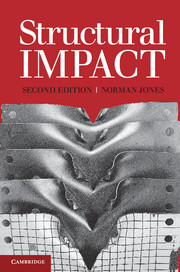Book contents
- Frontmatter
- Contents
- Preface to the Second Edition
- Preface to the First Edition
- Structural Impact
- 1 Static Plastic Behaviour of Beams
- 2 Static Plastic Behaviour of Plates and Shells
- 3 Dynamic Plastic Behaviour of Beams
- 4 Dynamic Plastic Behaviour of Plates
- 5 Dynamic Plastic Behaviour of Shells
- 6 Influence of Transverse Shear and Rotatory Inertia
- 7 Influence of Finite Displacements
- 8 Strain-Rate-Sensitive Behaviour of Materials
- 9 Dynamic Progressive Buckling
- 10 Dynamic Plastic Buckling
- 11 Scaling Laws
- Appendix 1 Principle of Virtual Work
- Appendix 2 Path-Dependence of an Inelastic Material
- Appendix 3 Principle of Virtual Velocities
- Appendix 4 Consistent Sets of Equilibrium Equations and Geometrical Relations
- Appendix 5 Buckingham Π-Theorem
- Appendix 6 Quasi-Static Behaviour
- Appendix 7 Martin’s Upper Bound Displacement Theorem
- References
- Answers to Selected Problems
- Author Index
- Subject Index
7 - Influence of Finite Displacements
Published online by Cambridge University Press: 05 June 2012
- Frontmatter
- Contents
- Preface to the Second Edition
- Preface to the First Edition
- Structural Impact
- 1 Static Plastic Behaviour of Beams
- 2 Static Plastic Behaviour of Plates and Shells
- 3 Dynamic Plastic Behaviour of Beams
- 4 Dynamic Plastic Behaviour of Plates
- 5 Dynamic Plastic Behaviour of Shells
- 6 Influence of Transverse Shear and Rotatory Inertia
- 7 Influence of Finite Displacements
- 8 Strain-Rate-Sensitive Behaviour of Materials
- 9 Dynamic Progressive Buckling
- 10 Dynamic Plastic Buckling
- 11 Scaling Laws
- Appendix 1 Principle of Virtual Work
- Appendix 2 Path-Dependence of an Inelastic Material
- Appendix 3 Principle of Virtual Velocities
- Appendix 4 Consistent Sets of Equilibrium Equations and Geometrical Relations
- Appendix 5 Buckingham Π-Theorem
- Appendix 6 Quasi-Static Behaviour
- Appendix 7 Martin’s Upper Bound Displacement Theorem
- References
- Answers to Selected Problems
- Author Index
- Subject Index
Summary
Introduction
The theoretical solutions for the static and dynamic plastic behaviour of beams, plates and shells were developed in the previous chapters for infinitesimal displacements. In other words, the equilibrium equations, which govern the response of these structures, were obtained using the original undeformed configuration. For example, the equilibrium equations (1.1) and (1.2) were derived for the beam element shown in Figure 1.1 by ignoring any deformations which would develop under the action of the external loads. It turns out that theoretical analyses, which incorporate this simplification, are often capable of predicting static plastic collapse loads which agree with the corresponding experimental results, as indicated in Figure 1.14 for the transverse loading of metal beams without any axial restraints at the supports.
It may be recalled from § 1.9 that the concentrated load which may be supported by an axially restrained rigid, perfectly plastic beam exceeds the associated static plastic collapse load for finite transverse displacements. In fact, it is evident from Figure 1.15 that the external load is about twice the associated static plastic collapse value when the maximum permanent transverse displacement equals the beam thickness. However, an element of the original beam cross-section is deformed severely and displaced considerably from its initial position, as sketched in Figure 7.1. This change of geometry is ignored in the theoretical methods which are presented in the previous chapters. It is evident that the equilibrium equations (1.1) and (1.2) no longer control the behaviour of a deformed beam element, and different equations are required. It transpires that the most important effect of this change is the development of the membrane, or in-plane, force, N, which is shown in Figure 7.1.
- Type
- Chapter
- Information
- Structural Impact , pp. 267 - 326Publisher: Cambridge University PressPrint publication year: 2011



